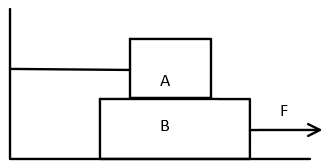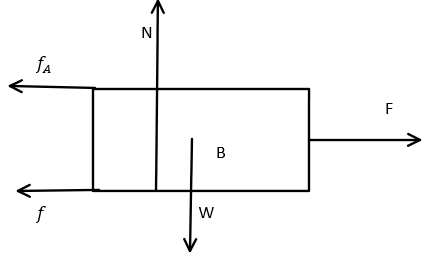Question
Question: Two blocks A and B placed on a plane surface as shown in the figure. The mass of block A is \(100\,k...
Two blocks A and B placed on a plane surface as shown in the figure. The mass of block A is 100kg and that of block B is 200kg. Block A is tied to a stand and block B is pulled by a force F. If the coefficient of friction between the surfaces of A and B is 0.2 and the coefficient of friction between B and the plane is 0.3 then for the motion of B the minimum value of F will be:

(A) 700N
(B) 1050N
(C) 900N
(D) 1100N
Solution
Hint To solve the question, you need to simply make the FBD (Free body diagram) of both of the blocks, block A and block B. The force F should be greater than all the friction forces that are trying to stop the block B from coming into motion. Since there are two surfaces of contact on B, there are two sources of friction instead of only one from the ground.
Complete step by step answer:
As explained in the hint section of the solution, we need to draw the FBDs of both of the blocks.
Let us starts with the FBD of block A first:

As we can see in the diagram, there are four forces acting on the block A:
WA is the weight of the block
NA is the normal force
T is the tension of the string and,
fA is the friction acting on the surface of contact of block A and B.
Since the mass of block A is given to us to be mA=100kg
We can conclude that the weight of block A will be
WA=mAg=100×10=1000N
Since there is no vertical motion of the block A, we can conclude that the normal force is equal to the weight of the block:
NA=WA=1000N
The coefficient of friction of the surface of contact of blocks A and B is given to be: μ1=0.2
Hence, we can say that the maximum friction that can act between the block A and B is:
fA=μ1N ⇒fA=0.2×1000N ⇒fA=200N
Now, let us have a look at the FBD of block B:

Here, W is the combined weight of the blocks A and B
F is the external force whose value is asked to us in the question,
N is the normal reaction force,
fA is the frictional force between the blocks A and B
f is the frictional force between the block B and the ground.
The mass of block B is given to be mB=200kg
So, the combined mass will be: m=mA+mB=100+200=300kg
Hence, the weight of the system becomes:
W=mg=300×10=3000N
Since there is no vertical motion in the system, the normal reaction force balances out the weight of the blocks, this can be written as:
N=W N=3000N
The coefficient of friction of ground is given to be: μ=0.3
So, the maximum value of the friction between the block B and ground becomes:
f=μN ⇒f=0.3×3000 ⇒f=900N
Now, for the block to move, the force on the rightwards must at least be equal to the force on leftwards, this can be written as:
FR=FL F=f+fA
Substituting the values of f and fA, we get:
F=900+200 F=1100N
As we can see, this matches with the value given in the option (D). So, option (D) is the correct answer.
Note
The most common mistake that many students make is that they take wrong directions of friction between the blocks, this in turn changes the final equation of balancing the forces towards left and right and leads them to a wrong answer.
